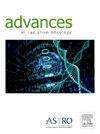National Trends in Radiation Treatment for Small Cell Lung Cancer Brain Metastases in the Modern Era
IF 2.2
Q3 ONCOLOGY
引用次数: 0
Abstract
Purpose
Small cell lung cancer (SCLC) is a highly aggressive form of lung cancer that often leads to brain metastases. Traditional treatment has largely relied on whole brain radiation therapy (WBRT). However, concerns about neurocognitive side effects have led to the adoption of advanced techniques such as hippocampal avoidance WBRT (HA-WBRT) and stereotactic radiosurgery (SRS).
Methods and Materials
This retrospective study used data from the National Cancer Database spanning from 2010 to 2021. The study included adult patients diagnosed with brain metastases from SCLC who received primary radiation therapy directed at the brain. Patients were categorized into 3 treatment groups: WBRT, HA-WBRT, and SRS. Statistical analyses, including logistic regression, Kaplan–Meier survival analysis, and Cox regression, were performed to identify predictors of treatment type and survival outcomes.
Results
The study analyzed 24,858 patients with a median age of 65 years. Over time, there was a significant increase in the use of advanced radiation techniques (HA-WBRT and SRS). SRS and HA-WBRT were associated with longer median survival (10.6 and 10.1 months, respectively) than WBRT (7.3 months). Factors such as advanced age, extracranial disease, and higher comorbidity scores were linked to poorer survival, whereas the use of chemotherapy, immunotherapy, and higher socioeconomic status were associated with improved outcomes.
Conclusions
From 2010 to 2021, there has been an increase in the use of more advanced techniques to treat brain metastasis from SCLC. These advanced techniques were associated with improved survival outcomes, although selection bias and the retrospective nature of the study limit definitive conclusions.
现代小细胞肺癌脑转移放射治疗的全国趋势
小细胞肺癌(SCLC)是一种高度侵袭性的肺癌,常导致脑转移。传统的治疗主要依靠全脑放射治疗(WBRT)。然而,对神经认知副作用的担忧导致采用了先进的技术,如海马回避WBRT (HA-WBRT)和立体定向放射手术(SRS)。方法和材料本回顾性研究使用了2010年至2021年国家癌症数据库的数据。该研究包括被诊断为SCLC脑转移的成年患者,他们接受了针对大脑的初级放射治疗。患者被分为3个治疗组:WBRT、HA-WBRT和SRS。统计分析包括逻辑回归、Kaplan-Meier生存分析和Cox回归,以确定治疗类型和生存结果的预测因素。结果该研究分析了24858例患者,中位年龄为65岁。随着时间的推移,先进放射技术(HA-WBRT和SRS)的使用显著增加。与WBRT(7.3个月)相比,SRS和HA-WBRT的中位生存期(分别为10.6和10.1个月)更长。高龄、颅外疾病和较高的合并症评分等因素与较差的生存率相关,而化疗、免疫治疗的使用和较高的社会经济地位与改善的预后相关。从2010年到2021年,使用更先进的技术治疗SCLC脑转移的情况有所增加。这些先进的技术与改善的生存结果相关,尽管选择偏倚和研究的回顾性性质限制了明确的结论。
本文章由计算机程序翻译,如有差异,请以英文原文为准。
求助全文
约1分钟内获得全文
求助全文
来源期刊

Advances in Radiation Oncology
Medicine-Radiology, Nuclear Medicine and Imaging
CiteScore
4.60
自引率
4.30%
发文量
208
审稿时长
98 days
期刊介绍:
The purpose of Advances is to provide information for clinicians who use radiation therapy by publishing: Clinical trial reports and reanalyses. Basic science original reports. Manuscripts examining health services research, comparative and cost effectiveness research, and systematic reviews. Case reports documenting unusual problems and solutions. High quality multi and single institutional series, as well as other novel retrospective hypothesis generating series. Timely critical reviews on important topics in radiation oncology, such as side effects. Articles reporting the natural history of disease and patterns of failure, particularly as they relate to treatment volume delineation. Articles on safety and quality in radiation therapy. Essays on clinical experience. Articles on practice transformation in radiation oncology, in particular: Aspects of health policy that may impact the future practice of radiation oncology. How information technology, such as data analytics and systems innovations, will change radiation oncology practice. Articles on imaging as they relate to radiation therapy treatment.
 求助内容:
求助内容: 应助结果提醒方式:
应助结果提醒方式:


